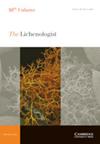Multilocus-phylogeny of the lichen-forming genus Bacidia s. str. (Ramalinaceae, Lecanorales) with special emphasis on the Russian Far East
IF 1.4
4区 生物学
Q4 MYCOLOGY
引用次数: 2
Abstract
Abstract To clarify deep relationships among species lineages within Bacidia s. str., and to investigate the robustness of the deeper branches, we combined data from three traditionally used RNA-coding genes (nrITS, nrLSU and mtSSU) with two protein-coding genes (RPB1 and RPB2). The multigene phylogeny contained 48 newly generated sequences from the Russian Far East and all Bacidia s. str. sequences from GenBank (131 sequences). We subjected the alignments for the single and concatenated data sets to Bayesian inference (BI) and two maximum likelihood (ML) analyses (RAxML and IQ-TREE). The topologies of phylogenetic trees recovered from BI and ML analyses were highly concordant. The multilocus phylogeny of Bacidia s. str. was congruent with previous results based on nrITS sequences from the Russian Far East but with considerably higher support values for most of the deeper branches. A correlation between the recovered clades and apothecial pigments in the upper part of the hymenium and lateral exciple was observed. Based on morphological and molecular evidence, Bacidia obtecta is described as new to science. It was recovered as the sister lineage of B. elongata. The two species are alike in having up to four enlarged lumina cells along the exciple edge, but B. obtecta differs in the abundant crystals found in the upper hymenium and lateral exciple, and by having spores with fewer septa.地衣形成属芽孢杆菌的多室系统发育,特别强调在俄罗斯远东地区
为了阐明芽孢杆菌(Bacidia s.str .)种系之间的深层关系,并研究其深层分支的稳健性,我们将三个传统的rna编码基因(nrITS、nrLSU和mtSSU)与两个蛋白质编码基因(RPB1和RPB2)的数据结合起来。多基因系统发育包括48个来自俄罗斯远东地区的新生成序列和131个来自GenBank的Bacidia s. str.序列。我们将单个和串联数据集的比对进行贝叶斯推理(BI)和两个最大似然(ML)分析(RAxML和IQ-TREE)。从BI和ML分析中恢复的系统发育树拓扑结构高度一致。Bacidia s. str.的多位点系统发育与先前基于俄罗斯远东地区nrITS序列的结果一致,但对大多数较深分支具有较高的支持值。发现的枝与胎膜上部和外侧鞘鞘色素之间存在相关性。基于形态学和分子证据,黑芽孢杆菌被描述为科学上的新物种。它被发现是B. elongata的姐妹系。这两个物种的相似之处在于,沿胚轴边缘有多达四个增大的腔细胞,但B. obtecta的不同之处在于,在胚轴上部和侧胚轴中发现了丰富的晶体,并且孢子的间隔较少。
本文章由计算机程序翻译,如有差异,请以英文原文为准。
求助全文
约1分钟内获得全文
求助全文
来源期刊

Lichenologist
生物-真菌学
CiteScore
2.90
自引率
14.30%
发文量
23
审稿时长
6.0 months
期刊介绍:
The Lichenologist is the premier scientific journal devoted exclusively to the study of lichens worldwide. As the leading forum for the dissemination of new concepts and topical reviews, The Lichenologist reaches more scientists concerned with the study of lichens and lichen symbionts than any other single journal. All aspects of lichenology are considered including systematics and phylogenetics; molecular biology; ultrastructure, anatomy and morphology; secondary chemistry, effects of pollutants and use as bioindicators; biogeography. In addition to standard length research papers, the journal also publishes Short Communications and Book Reviews. A monthly issue may occasionally be devoted to papers deriving from a symposium.
 求助内容:
求助内容: 应助结果提醒方式:
应助结果提醒方式:


